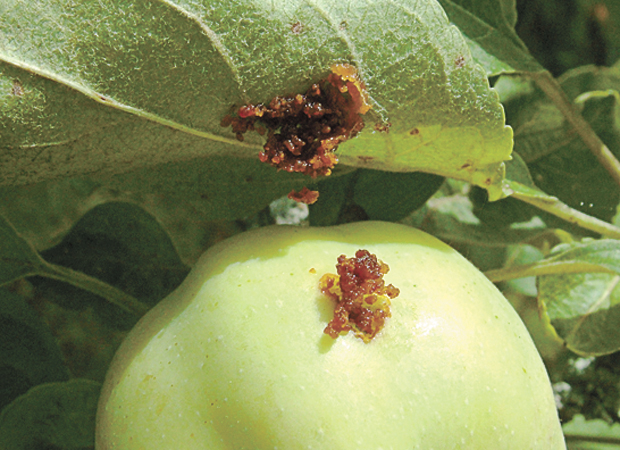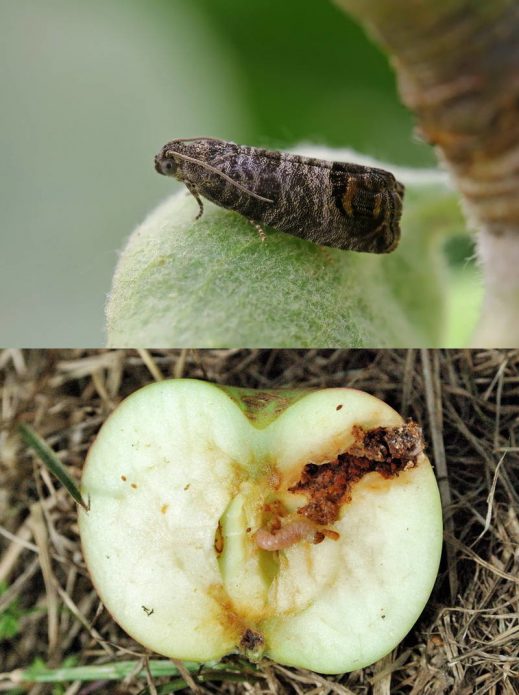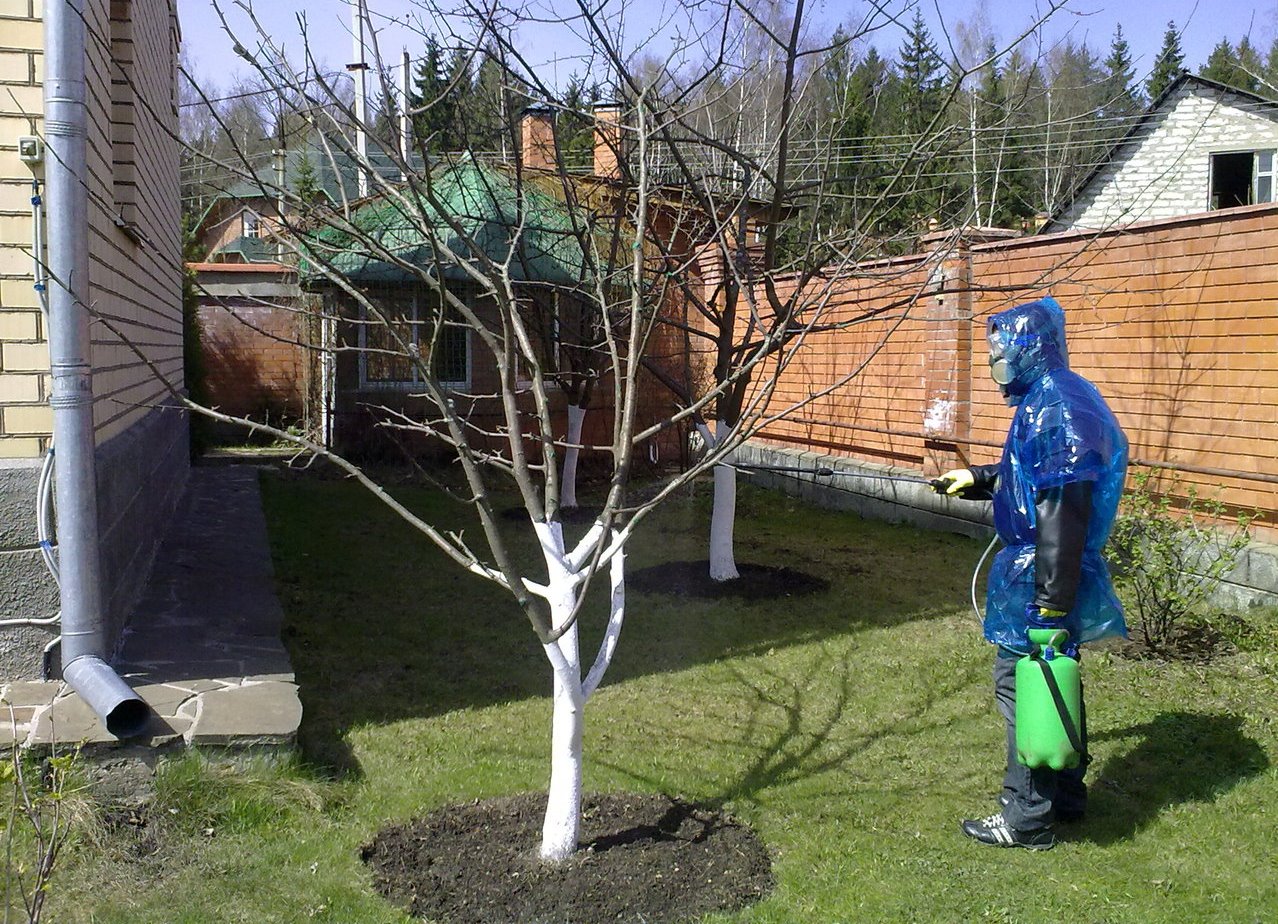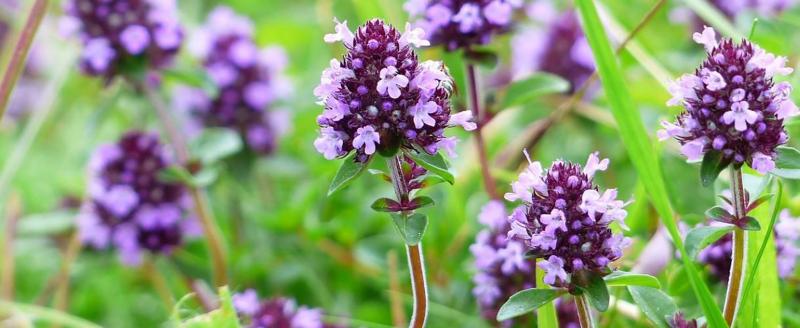Neither the owners of private gardens nor the heads of large fruit and berry plantations are insured against the appearance of the moth. The fight against it can last more than one month, stretching in some cases for many years. Knowledge about its life cycle, developmental features and methods of counteraction successfully tested by gardeners will increase the effectiveness of preventive measures and means of protection against pests.
Content
Who is the moth
Moth is a butterfly, an agricultural pest that affects the fruits of trees. Outwardly, an adult individual practically does not attract attention to itself. This butterfly is nocturnal, so the scales on its wings have a nondescript color, which allows it to camouflage on the bark of a tree during oviposition. The breeding period starts simultaneously with the beginning of flowering and lasts 1.5–2 months. During this time, one female manages to lay up to 120 eggs on the bark, leaves and branches of the chosen plant.
After a few days, the caterpillars hatch, the resulting ovaries serve as food for them. After 1–1.5 months, they hide under the bark or in the ground for pupation and the appearance of new individuals. Three generations hatch during the season, each of which has time to lay eggs. The latter does not have time to pupate: cocoons hibernate under fallen leaves, in containers for storing fruits, in warehouses. As soon as the temperature of the ambient air overcomes the border of 10 ° C, an adult butterfly will emerge from the cocoon - the process will be repeated from the very beginning.
Apple, pear and plum: types in the photo
The fruit moth affects the fruits of apple, pear, quince, plum, blackthorn, sweet cherry, cherry plum, nectarines, apricots and peaches.
Damaged fruits seem to be prematurely ripe, for the most part they fall off, often together with caterpillars.
You can distinguish the moth by its appearance:
- in the codling moth butterfly, the front wings are dark gray, the lower ones are brown, caterpillars are light pink in color with a black head, and the eggs are milky white;
- in the pear moth, the wings are darker, the caterpillars are yellow-brown, and the eggs are with a pinkish tint;
- in the plum moth, the wings have a purple tint, the eggs are greenish, it settles not only on plums, but also on other representatives of stone fruit crops: cherries, nectarines, peaches.
How to spray with chemicals
Chemistry on the site is heavy artillery, which is used when preventive measures and folk remedies have not helped. Processing is carried out four times:
- the first time - at the time of flowering plants;
- the second and third time - with a two-week interval;
- fourth time after harvest.
Atom
A synthetic preparation in the form of a concentrated emulsion with a broad spectrum of action. For spraying apple trees, 5 ml of the product is diluted in 10 liters of water. This volume is enough to handle 100 sq. m garden. Processing is carried out twice during the growing season, completing 30 days before harvest. You can start other work in the garden a week after spraying. Toxic to bees.
Zolon
The consumption of the drug depends on the type of plant being treated: for apple trees it is 8 ml per 100 sq. m, for pears, plums, cherries and apricots - 25 ml, for peaches 14 ml. The required amount is diluted in 10 liters of water and start spraying. The last processing is carried out 40 days before the expected date of harvest. It is toxic to fish, therefore it is not used in the water protection zone.
Iskra-M
The malathion emulsion is available in the form of 5 and 10 ml ampoules. The contents are diluted with water in a ratio of 1: 1000, at least 10 liters of the finished product will be needed per 1 hundred square meters of the garden. The processing of apple and pear trees is carried out twice a season - before flowering and after harvesting, and it is allowed to spray cherries and plums 4 times a summer.
Ivanhoe
For spraying, 10 ml of concentrate is diluted in 10 liters of water, this amount is enough to process 200 sq. m garden. A double treatment is enough. Safe for bees, not washed off by sediments.

From late May to mid-September, depending on the climatic zone, all stages of moth development are simultaneously encountered in the orchard
Sumi-Alpha
A solution for spraying apples, pears, plums and apricots is prepared at the rate of 5 ml per 10 liters of water. The interval between treatments is maintained for 3 weeks, the last time it is sprayed two weeks before the expected date of harvest.
Kinmix
Used for plums and cherries, diluting 15 ml in 10 liters of water. The maximum number of treatments does not exceed 2 times per season.
Lepidocide
Available in 5 ml ampoules. To prepare a solution, 4 ampoules are diluted with 10 liters of water. This amount is enough to process 5 trees.
Bitoxibacillin
Produced in sachets of 20 g. For spraying 5 fruit trees, 40 g are diluted in 10 liters of water.
Alone, moths are difficult to destroy: control measures must be taken by all neighboring farms. This is the only way to achieve maximum results.
Average cost of drugs against the moth
| Group of drugs | Name | Cost, rub. |
| Insecticides (directed against caterpillars) | Atom (5 L) | 7600 |
| Zolon (5 l) | 11500 | |
| Iskra-M (5 ml) | 30 | |
| Pyrethroid (directed against adults) | Ivanhoe (5 L) | 6500 |
| Sumi-Alpha (5 l) | 9700 | |
| Kinmix (5 l) | 5600 | |
| Biologicals | Lepidocide (5 ml) | 45 |
| Bitoxibacillin (20 g) | 60 |
Folk remedies for processing
General rules on how to spray apple and other trees from the moth:
- the first spraying is carried out at the time of flowering of fruit trees;
- the next two - with a two-week interval;
- processing is carried out in the absence of rain and wind, in the evening;
- observe safety measures - protect face and hands, do not allow contact with eyes, etc.
Tobacco broth
You will need 0.5 kg of dry tobacco, 20 liters of water and 50 g of laundry soap. Tobacco is poured into 10 liters of water and infused for 2 days. The infusion is boiled for 2 hours and diluted with another 10 liters of water. Immediately before spraying, rub the soap into the container.
A fairly effective measure is the creation of feeders that will help attract insectivorous birds to the garden.
Wormwood broth
Another remedy for the moth is wormwood broth. Wormwood herb and water are used as ingredients. 1 kg of green mass is poured with a bucket of water and boiled for 20 minutes. Cool, dilute with 10 liters of water and send for processing.

Butterflies hide well in the foliage during the day, and the eggs are covered with a glued sheet; the caterpillar in the depth of the apple is not available for poisons
Pepper broth
You can try to get rid of the apple moth with the help of pepper broth.To prepare it, you will need red hot peppers, water and laundry soap. 0.5 kg of pepper pods are poured into 2 liters of water and brought to a boil. The broth should boil for at least an hour under the lid, after which it is sent for infusion for 2 days. The infusion is filtered and stored in a dark bottle in a cool place. To process the territory, 0.5 liters of strained infusion is diluted in 10 liters of water and 50 g of finely shaved soap is added.
Tomato infusion
The tops, roots and green fruits of tomatoes are crushed and poured with water in a ratio of 2: 5. After boiling for half an hour, the solution is filtered and stored in a cool place. For spraying, 3 liters of the mixture is diluted with 10 liters of water and rubbed with 50 g of soap.
How trapping belts will help
Trapping belts can help you fight moths. To make them, you will need a piece of paper, cloth or burlap, from which you need to cut strips 25–30 cm long. The tree trunks are wrapped with them at a height of 30–40 cm from the ground. Above, the trap must be fixed with twine, at the bottom it must be free. When the caterpillar starts climbing up the trunk, it will end up trapped. From the trapping belts, you need to regularly remove and destroy the insects that have got there. For greater efficiency, you can spread track glue on the traps.
Caterpillar glue is a thick, non-drying, sticky mass that is applied in a thick layer to the underside of the tree trunk. Such a sticky belt does not allow pests to climb higher and get into the crown.
Fighting caterpillars with pheromone traps
In recent years, pheromone traps have been used. Females of many insect species, attracting males, secrete pheromone volatiles with high physiological activity. Males feel them tens and hundreds of meters away. Scientists have succeeded in synthesizing pheromones of a number of insects, including the apple, plum and oriental moth, bunch moth, and the Californian scale insect. They are used to determine the onset of the appearance of butterflies, which allows you to establish the optimal timing for pest control. So, if more than 5 moth moths of the first generation and more than 2–3 of the second generation have fallen into one trap during the week, it is necessary to start chemical treatment of the garden.
It is important that pheromones are applied to all areas near your garden at the same time.
After 6-10 days, necessary for the laying of eggs and the appearance of caterpillars, the first chemical treatment is carried out. As a result of the capture of males, some of the females remain unfertilized and unable to bear offspring.
Under natural conditions, pheromones retain their effect for 1–1.5 months and attract male moths at a distance of up to 50 m. After the expiration date, they hang out a new equipped trap or change the pheromone source to the old one.
How to remove an apple moth on video
Reviews about the effectiveness of folk and industrial remedies
We saw how many butterflies are stuffed into light traps, they fill any surface with a full layer overnight, some get out of the trap (a container with sweet water) but cannot fly away, and a hedgehog is waiting for them here, I plan to get bats, but with a huge abundance of butterflies without With the right chemicals, the crop is very difficult to save.
In addition to spraying with karbofos, I can not offer anything less chemical. All methods with traps with sugar syrup, or even more interesting, as recommended in special literature, mechanical trapping - nothing gives such an effect as treatment with chemistry.
Infusion of garlic is good to use in the fight against moths, aphids, copperheads, ticks. I usually take 150-200 grams of garlic and grind it in a meat grinder, add 10 liters of water, leave for 5-7 days. Then I filter the solution and process the trees. It is advisable to use a fresh solution, usually on the second day the pests die.
You can also peel off old bark on trees in the fall and spring to remove cocoons with overwintering caterpillars. Collect carrion daily. It is helpful to lightly shake the tree periodically to control the loss of damaged fruit.
In the fight against this pest, the destruction of plant residues, autumn plowing of row spacings and tillage in the near-trunk circles will help. Spraying is carried out with approved insecticides - "Zolon", or "Sumition" before the start of the mass laying of eggs in about 1-3 ten days of July. The last treatment is 30 days before harvest.
There are many ways to fight, but one that is safe for both plants and humans is more preferable. For this we use camphor alcohol. We saturate 7-8 pieces of cotton wool or scraps of fabric (for an adult tree) and hang them in the crown of the tree. Unfortunately, alcohol quickly evaporates, so after a week we repeat the whole operation. Camphor is not absorbed into the fruit, but about a month before harvesting, we remove these "flavorings" from the tree. Along with this, we hang trapping belts on the trees, which remain there for the whole summer. But there are not many pests under them.
Each of the methods of controlling the fruit moth moth separately will not provide guaranteed protection from the pest. An integrated approach is needed, in which agrotechnical methods are supplemented with chemicals and proven folk remedies. For less harm, the new spray is tested on one plant and, if no side effects are present, the entire garden is treated.






